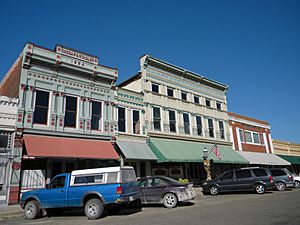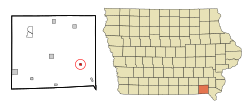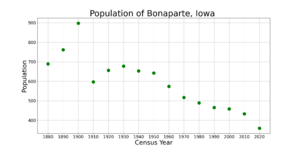Bonaparte, Iowa facts for kids
Quick facts for kids
Bonaparte, Iowa
|
|
|---|---|
 |
|

Location of Bonaparte, Iowa
|
|
| Country | |
| State | |
| County | Van Buren |
| Area | |
| • Total | 0.37 sq mi (0.97 km2) |
| • Land | 0.37 sq mi (0.97 km2) |
| • Water | 0.00 sq mi (0.00 km2) |
| Elevation | 597 ft (182 m) |
| Population
(2020)
|
|
| • Total | 359 |
| • Density | 959.89/sq mi (370.56/km2) |
| Time zone | UTC-6 (Central (CST)) |
| • Summer (DST) | UTC-5 (CDT) |
| ZIP code |
52620
|
| Area code(s) | 319 |
| FIPS code | 19-07345 |
| GNIS feature ID | 2394217 |
Bonaparte is a small city in Van Buren County, Iowa, United States. In 2020, about 359 people lived there.
The city is located along the Des Moines River. It has many old buildings that show its history, including a large pottery.
Contents
History of Bonaparte
The area where Bonaparte is now was first settled in 1837 by William Meek. He named it Meek's Mill. In 1841, the town was re-planned and its name was changed to Bonaparte.
William Meek admired the French Emperor Napoleon Bonaparte. He also tried to start another town called Napoleon across the river, but it never grew. Bonaparte officially became a city in 1899.
The town faced a big flood in 1851.
Bonaparte is also on the historic Mormon Trail. This was a path used by early settlers. Several places in or near Bonaparte are listed on the National Register of Historic Places. These are important historical sites.
- Aunty Green Hotel
- Bonaparte Historic Riverfront District
- Bonaparte Pottery Archeological District
- Meek's Flour Mill
- Des Moines River Locks No. 5 and No. 7
A famous person named Charles E. Pickett, who served in the U.S. Congress, was born near Bonaparte.
Geography of Bonaparte
Bonaparte is located in southeastern Iowa. Its exact position on a map is 40.699914 degrees north and -91.800837 degrees west.
The United States Census Bureau says that the city covers about 0.37 square miles (0.97 square kilometers). All of this area is land.
Population and People
| Historical populations | ||
|---|---|---|
| Year | Pop. | ±% |
| 1880 | 689 | — |
| 1890 | 762 | +10.6% |
| 1900 | 898 | +17.8% |
| 1910 | 597 | −33.5% |
| 1920 | 656 | +9.9% |
| 1930 | 678 | +3.4% |
| 1940 | 653 | −3.7% |
| 1950 | 642 | −1.7% |
| 1960 | 574 | −10.6% |
| 1970 | 517 | −9.9% |
| 1980 | 489 | −5.4% |
| 1990 | 465 | −4.9% |
| 2000 | 458 | −1.5% |
| 2010 | 433 | −5.5% |
| 2020 | 359 | −17.1% |
| Source: and Iowa Data Center Source: |
||
2020 Census Information
In 2020, there were 359 people living in Bonaparte. There were 168 households in the city. The city had about 960 people per square mile (370 per square kilometer).
The average age of people in Bonaparte was about 37.6 years old. About 29.5% of the residents were under 20 years old. About 20.6% were 65 years or older. The population was almost evenly split between males (50.1%) and females (49.9%).
2010 Census Information
In 2010, the city had 433 people. There were 190 households. The average age was 37.3 years. About 25.4% of residents were under 18. About 15.2% were 65 or older.
Education in Bonaparte
Students in Bonaparte attend schools in the Van Buren County Community School District. This district was formed in 2019 when the Harmony Community School District joined with Van Buren County CSD.
Notable Person
- Ida Sedgwick Proper, a writer and supporter of women's right to vote, was connected to Bonaparte.
See also
 In Spanish: Bonaparte (Iowa) para niños
In Spanish: Bonaparte (Iowa) para niños


